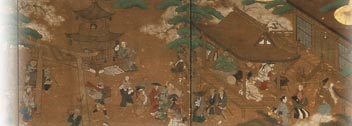International Conference "An Invitation to Dance Studies: 'Le Sacre du Printemps' Revisited"
Outline
| date | January 29–30, 2008 |
|---|---|
| Venue | Ono Auditorium |
| Organizer | |
| outline | International Conference "An Invitation to Dance Studies: 'Le Sacre du Printemps' Revisited" |
Details
The Dance Research Course of the International Institute for Education and Research in Theatre and Film Arts held an international conference titled "An Invitation to Dance Studies: 'Le Sacre du Printemps' Revisited", with lectures by guest speaker Janet Lansdale, emeritus professor at the University of Surrey, and leading researcher in dance studies in the UK. The first day featured a lecture by Lansdale. The second day featured a keynote lecture by Lansdale followed by a symposium titled "Nijinsky's Choreography: A Reconsideration of 'Le Sacre du Printemps'". This summary will concentrate on the symposium, leaving a report of Lansdale's lectures to another occasion.The year 2009 marks the centenary of the founding of the Ballets Russes (1909-1929), which under the directorship of Sergei Diaghilev was one of the most influential ballet companies in the 20th century. Our symposium was thus in the forefront of a series of events scheduled to take place worldwide in celebration of the centenary. The Ballets Russes' performance of "Le Sacre du Printemps" with original choreography by Vaslav Nijinsky marked an important pivotal point in the more than 20 years of the life of the ballet company. As Modris Eksteins emphasizes in his book, which shares the title of Stravinsky's work, this piece altered the course of musical and ballet history, causing riots in its day, and is associated with the birth of the modern age.
Sho Suzuki, chair of the symposium, gave the first presentation, in which he provided an account of the basic facts of "Le Sacre du Printemps" and its place in the history of dance. "Le Sacre du Printemps" was only put on nine times with Nijinsky's choreography because Nijinksy left the Ballets Russes. But the music for the piece, composed by Igor Stravinsky, has been spoken of as the singlemost important musical masterpiece of the 20th century, and has continued to inspire the creative impulse of choreographers for more than 100 years right down to the present day. Choreographers who have attempted to reshape this music to meet their own creative desires include Leonide Massine (1920), Marie Wigman (1957), Maurice Béjart (1959), Kenneth MacMillan (1962), Natalia Kasatkina, Vladimir Vasilyov (1965), John Neumeier (1972), Pina Bausch (1975), Paul Taylor (1980), Martha Graham (1984), Mats Ek (1984), Lin Hwai Min (1984), and Jean-Christophe Maillot (1985). The original Nijinsky choreography, on the other hand, was reconstructed by Millicent Hodson, and staged by the Joffrey Ballet Company in 1987. It is impossible to know how faithful this reconstruction was to the actual original choreography, but it has now become part of the repertory of contemporary ballet troupes such as the Paris Opera Ballet, the Mariinsky Ballet, and the Finnish National Ballet.
Mitsuyoshi Numano, professor at the University of Tokyo, reaffirmed the role played by Nikolai Roerich (or Rerich) in "Le Sacre du Printemps". Known for having been in charge of set design in the original production, Roerich's influence in fact went far beyond this: he was involved with many aspects of the piece, right from the stage of conception. In his autobiography Stravinsky talks as if he were the one who conceived the idea, and for many years he was indeed regarded as the author of "Le Sacre du Printemps"; but it is now clear from studies by Kenneth Archer and other researchers that Roerich was the actual author of the work. Roerich subsequently left the world of ballet, going on to be active in a number of spheres - as an artist of mystical realism, a thinker in theosophy, the author of a book Shambhala (named after a mythical kingdom somewhere in Tibet), and also the person who drew up the Roerich Pact of 1935, an international agreement that aimed to protect cultural treasures from the impact of war. Numano's talk gave a fascinating indication of the influence that "Le Sacre du Printemps" had across the length and breadth of Roerich's activities. Professor Ichiro Ito of Waseda University then discussed aspects of the music of "Le Sacre du Printemps". This work is acknowledged to have flown directly in the face of Western classical music as it had existed previously. It is often said that the use of dissonance, the asymmetric beat, and the strange polyrhythms in the piece reflect the influence of Russian folk music. Ito asserted that Stravinsky's view that musical revolution must lie at the root of musical creativity is very strong in this work as well. Motoko Hirayama, now a full-time lecturer at the University of Tsukuba, gave an account of her experience as dancer in the first Japanese production, in 2005, of Hodson’s reconstruction of "Le Sacre du Printemps", at the Hyogo Performing Arts Center. Hirayama danced the role of the maiden who has to dance herself to death for the good of the tribe in the second half of the piece. Hirayama focused in particular on the directions given her by Hodson. This was then followed by a discussion by all participants.
As stated above, 2009 marks the hundredth year since the founding of the Ballets Russes. The GCOE Dance Research Course at Waseda University plans to hold another symposium on dance, this time on the meaning of the Ballets Russes for the present day.


